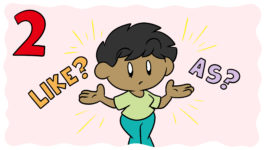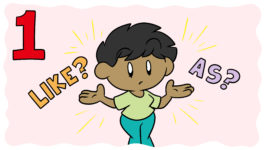Characters are the beating heart of any story. Even those authors who attempt to eschew this basic building-block of storytelling usually end up forcing inanimate objects to fill the gap, attributing personality to hills, cities and vehicles.
Of course a character doesn’t justify a story all by themselves. No matter how interesting a character, we almost always join them at a point of change. There’s a reason we, as an audience, are invited to meet that character, and it’s usually to observe as they go through trials and tribulations and change as an individual.
This is the character arc, a much-discussed aspect of storytelling that gives a story pace, purpose and context. In the same way that most people would tell you that a story needs a beginning, a middle and an ending, most authors would tell you that a character arc is essential to writing a good story.
Of course just like the former advice, in art there are always exceptions.
Abandoning the arc
Before exploring these exceptions, however, it’s important to acknowledge that character arcs are important. They create the sense of a ‘journey’ through the book, and allow the readers to both understand and be surprised by interesting characters. Eschewing the character arc shouldn’t be done lightly, and only in instances where you think it genuinely helps your story to have a character end their adventures as the same person who began them.
So what would instances such as these look like? While there’s a rainbow of possibilities, for the convenience of discussion we can group them into four categories:
- Focus on setting or situation
- Exploration of character or philosophy
- Contrast to other characters
- Mirroring the arc
These categories are by no means mutually exclusive – in fact you’ll usually find more than one of them at play – and working either alone or together they are powerful storytelling techniques.
1. Focusing on setting and situation
One reason a writer might abandon a character arc is because the character is simply a device for exploring a setting or situation. Here the story still needs the character but mostly as a tool to progress through the narrative. This can be seen in a lot of pulp fiction. Here writers often engage in ‘genre fiction’, where it’s assumed that the reader understands the traditions of a genre and is interested in how the author engages with them. In such instances authors will often use ‘stock characters’ – uncomplicated characters who play a familiar role.
In cases like this it would actually be distracting for the character to change over the course of the story, since their consistency is key to allowing experimentation in other areas. Here the character acts as a point of mutual understanding, a bedrock from which the author can build in safety.
This same effect can be applied to work which is not ‘genre fiction’, but authors should be careful. There’s a huge difference between using a consistent character to showcase other elements of a story and not bothering to create interesting characters because you’re caught-up in worldbuilding. To make sure you’re doing the former, ask yourself how the reader’s ability to rely on the character actively helps their experience elsewhere. If you have an answer then fantastic, if not, then it’s time to reflect on your real motivation.
2. Exploring a character or philosophy
The flipside of focusing on setting is exploring a character or their philosophy. Here there is no character arc because the purpose is to fully explore the character that already exists. You don’t want them changing for the same reason you don’t turn over the page before you’ve finished reading it.
This is partially the case for the character Rorschach in Alan Moore’s Watchmen. This unhinged vigilante is frequently loathsome, but possesses a consistent moral code which Moore’s story tests to destruction. Rorschach’s key characteristic is his inability to compromise on his beliefs. With the rest of the cast he is put through the ringer, but after myriad trials and a philosophy-warping final act he alone ends the story seemingly unchanged.
This lack of transformation is highlighted by the growing stakes of the plot – his black and white moral judgement is the same whether he is stopping muggers in the first chapter or facing a nuclear war in the last.
This device only works with deep or fascinating characters, and just as with the previous technique it’s important to make sure you’re doing it for the right reasons. Be sure the character’s initial state is as interesting as you think it is before abandoning any idea of them changing.
3. Contrast to other characters
One of the most frequent reasons to abandon the idea of a character arc is to create a character who functions to emphasize the arcs of others. One character’s personal journey is even more apparent when the reader can compare their ‘start’ and ‘end’ personas against someone who hasn’t changed throughout.
This is the case for the character of Granny Weatherwax in Terry Pratchett’s Discworld series. In some ways as much of an absolutist as Rorschach, Granny is the most capable person in any room. This perfectly sets up other characters to grow alongside her – over the course of several books Granny is contrasted with novice witch Magrat Garlick. This character starts off lacking confidence, but grows into a competent character and eventually becomes a deserving queen.
Magrat’s journey is made more striking by Granny Weatherwax’s consistency, and the way their relationship changes. In Carpe Jugulum Magrat, now a queen, is asked to make tea by Granny Weatherwax. This is an echo of her original subservient role, but in a position of power the request is far different. Magrat still makes the tea, but now she is choosing to do so out of respect and fondness. If Granny Weatherwax had herself changed as a character the subtlety of this distinction would be lost.
While less risky than other devices, it’s important to remember that the arcless character must still be interesting. If they’re just a prop for comparison then the reader will tire of them, and their effectiveness will be lost. As mentioned previously, these techniques seldom exist in a vacuum, and Pratchett also uses Granny to explore, critique and celebrate the philosophy of the canny and powerful elderly woman.
4. Mirroring the arc
Another frequently used device, mirroring the character arc is a cross between having a full character arc and having none at all. The idea here is that the lack of change in a character fulfills the same narrative function as a change would have – they go through the same process, but the fact that they remain unchanged tells us something about the character and has its own narrative power.
This is certainly the case in Watchmen. Rorschach’s inability to change has a profound effect on the reader, even though there are several ways to interpret it. Is he a man of unshakable and admirable conviction or a philosophically limited brute? Either answer draws the reader into the character and enhances their experience.
A key part of this device is that it follows the usual path of a character arc. The character faces challenges that test their beliefs and ideals, and are finally confronted by a situation which will test their own conception of who they are. In the character arc, this results in behavior which emphasizes the change. In the mirrored arc it proves that no change has taken place and, crucially, expounds on why that is.
Working without an arc
Like any core idea, the concept of a character arc was made to be tested. Doing so can often result in fantastic storytelling, so long as the author is deliberately abandoning this facet of storytelling to create a positive result. Often we can fall into the trap of ignoring something we find difficult and then justifying our behavior. Make sure this isn’t the case by listing your reasons for not having a character arc – remember, you’re allowed more than one.
For more on character arcs you can try How to write compelling character arcs in a series, or check out Enthrall your readers with a complex antihero for advice on writing the type of character who usually benefits the most from a well-considered arc.
Do you have a favorite book that lacks a character arc, or have you read something with an arc you didn’t believe? Let me know in the comments.






9 thoughts on “Does Every Story Need A Character Arc?”
Hi Rob, interesting. I have one book, but maybe I am wrong: “Fight Club”: what can you tell me about it?
[spoiler]
Rorschach reminds me of Scarface: the fact that they don’t change is the reason of their death.
I have a suggestion: the font of this site has become really “slim”, not so easy to read on some browsers. Can you get it bolder? Like, at least: https://medium.com/life-learning/work-hard-live-well-ead679cb506d
Thanks!
Hi Boostwriter,
I’ll have someone look into the font issue and will send you an email today about it.
Thanks,
Alex
I can’t subscribe to replies… correct?
That functionality has just been reenabled today , so you can subscribe to comment replies again.
Hi boostwriter,
I see that Alex has gotten back to you on the font issue. In terms of the character arc of Fight Club, I’d say there are a few ways to view it. The narrator seems to create the Tyler Durden personality precisely because he CAN’T change through less extreme means. In facing this other character, and taking steps to stop him, he does change – it’s just that the change is less evident since his internal struggle is represented as an external struggle with another character.
The reason he wants to change is because a) he’s unhappy with his life and b) he wants to start a relationship with Marla Singer. He ends with a much more exciting life, and a relationship with Marla, but since the final act is really him overcoming his most extreme side, we don’t get to see too much of the new him.
So I’d say there is a character arc here, it’s just that typical to Chuck Palahniuk it’s represented in quite an obtuse way. Hope that’s useful!
Best,
Rob
Thanks, Rob, very useful!
Thanks.
Your #3 is what K. M. Weiland calls a “flat arc.” The main character doesn’t himself change, but instead he changes someone else or he changes the world around him.
Hi Rod,
Thanks for commenting, and for sharing your knowledge.
Best,
Rob